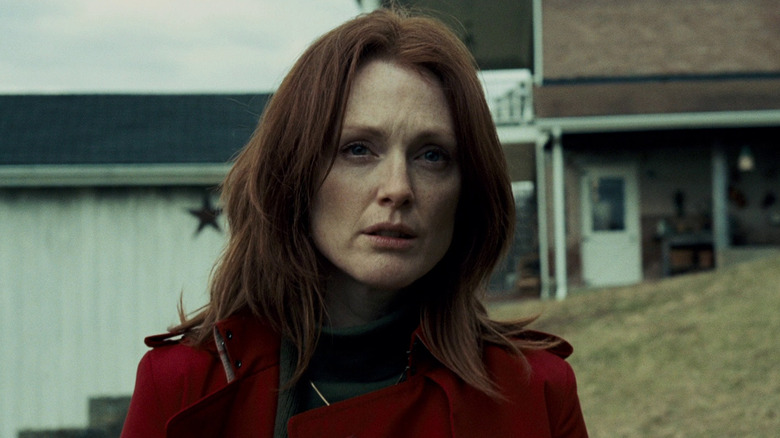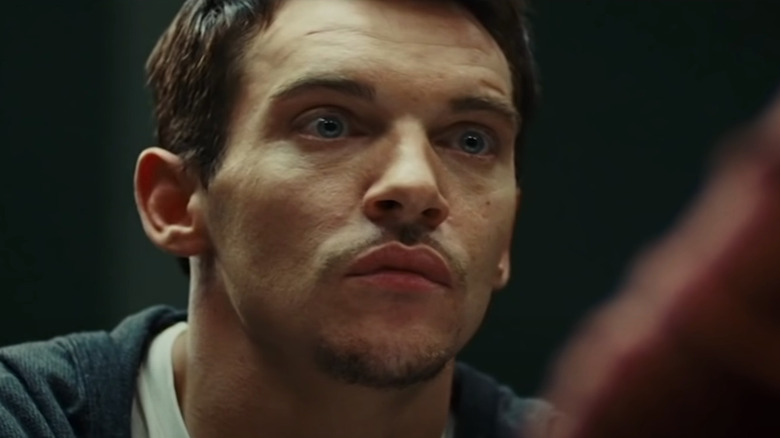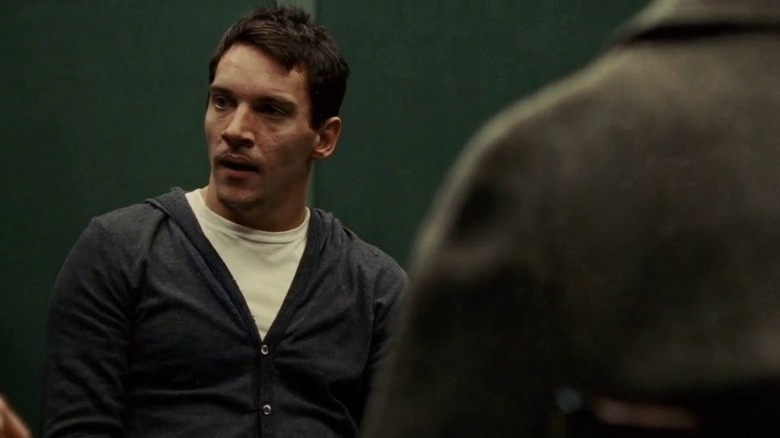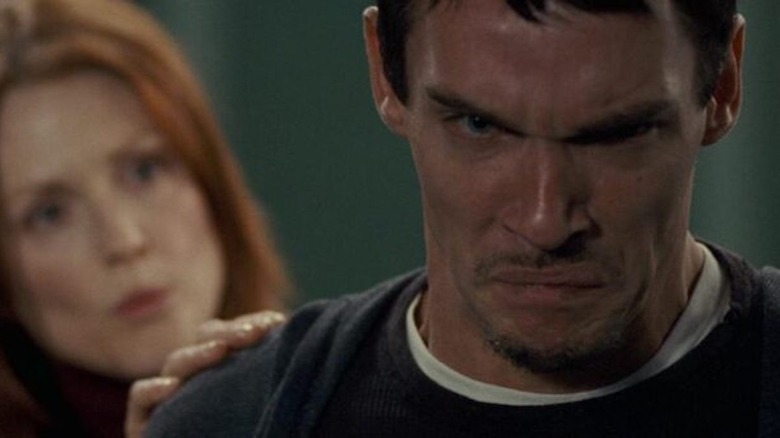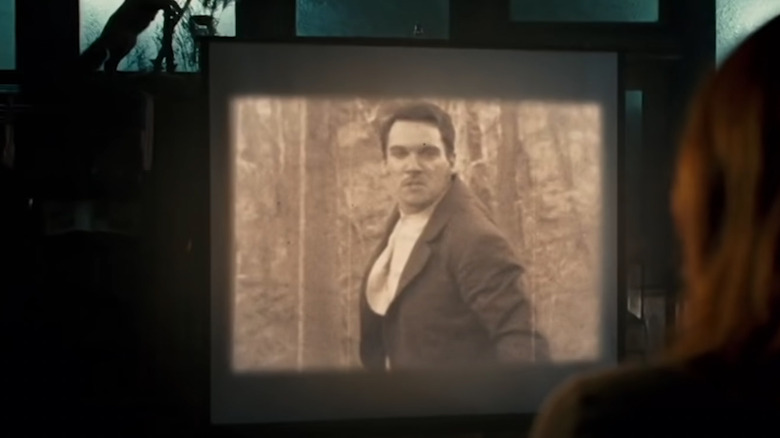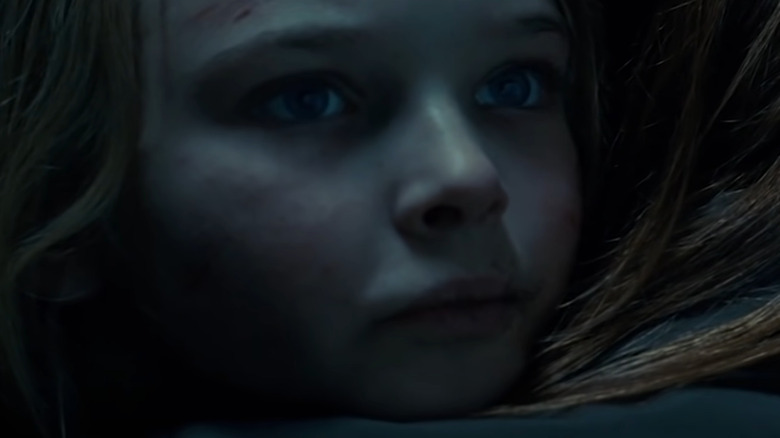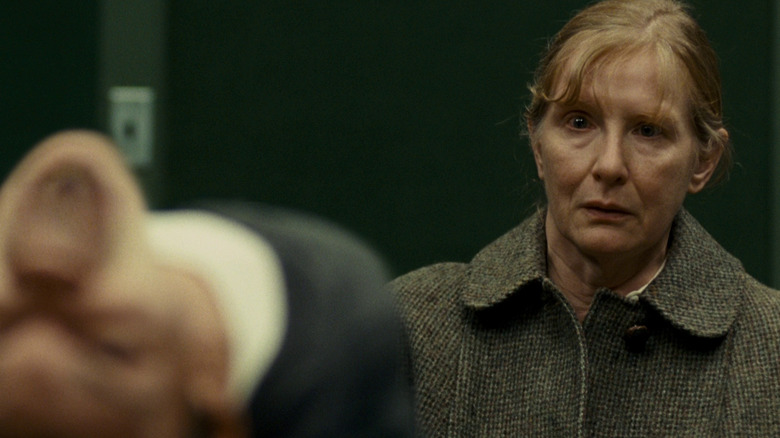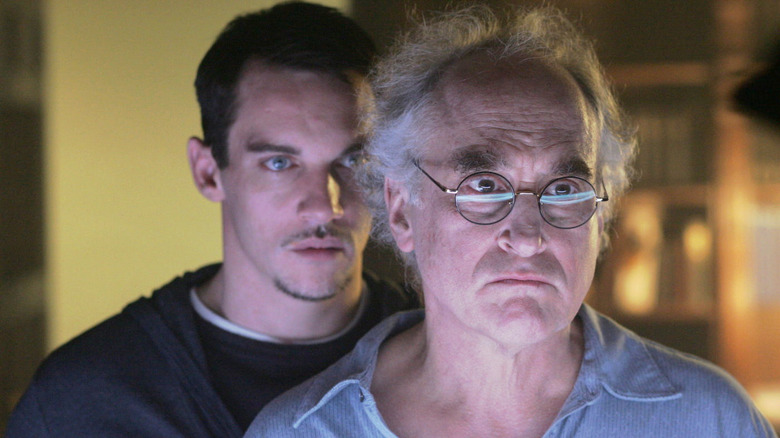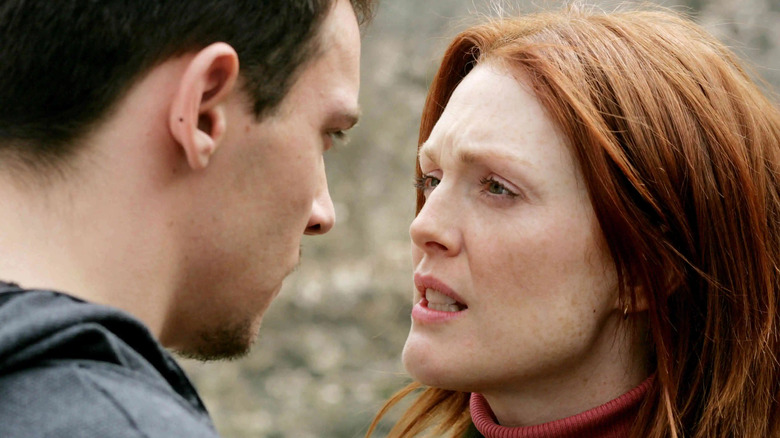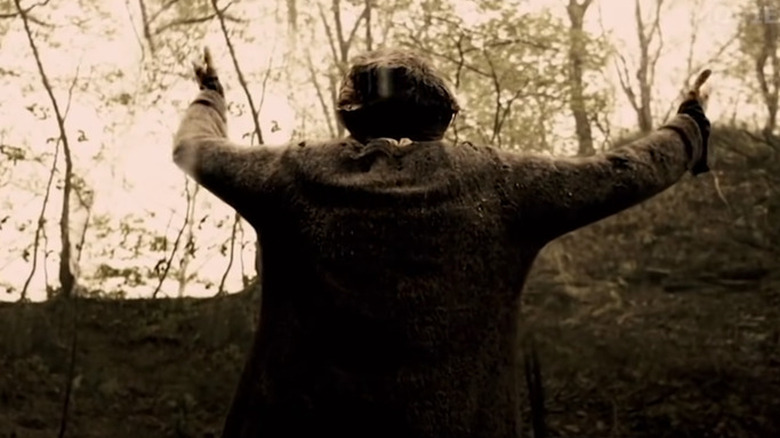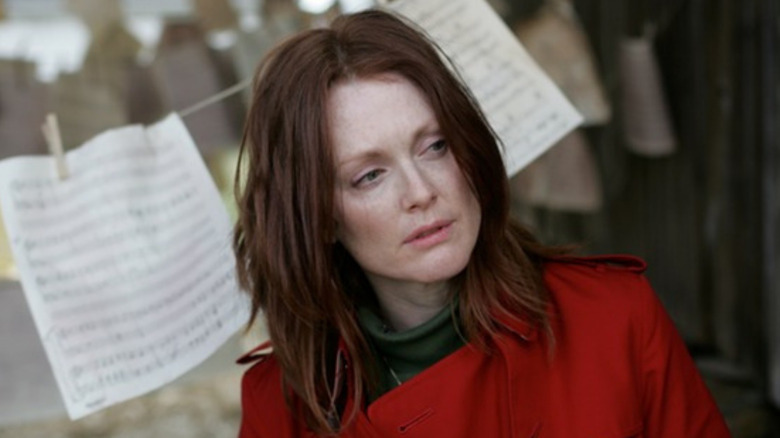The Ending Of 6 Souls Explained
Released in 2013 for American audiences, "6 Souls" (alternatively titled "Shelter" for some international viewers) was written by Michael Cooney, and is among the limited collection of feature films from Swedish director Mans Marlind. Best known for helming the fourth entry in the "Underworld" series, "Underworld: Awakening," "6 Souls" predates Marlind's time dabbling in big-budget franchise projects by two years, but adopts a similarly moody tone, balanced by a more grounded look at the supernatural.
A mind-bending thriller tackling themes of grief, the occult, religion, and more, "6 Souls" flopped hard at both the box office and among critics. It might not deserve all the flak it gets, though, since beyond just a capable cast including Julianne Moore and Jeffrey DeMunn in lead roles, the film brings interesting concepts and scares able to rattle the steeliest of stomachs.
"6 Souls" admittedly gets a bit complicated over the course of its nearly two-hour runtime. From keeping track of one character's multiple personalities to understanding the deranged witches living in the mountains, fans may be left with plenty of questions at the end of the supernatural thriller, some of which don't have the easiest of answers. With that in mind, we've set out to clear up any lingering questions you might have about the ending of "6 Souls," and to even dive a little deeper into what creators and audiences have had to say about it.
What you need to know about 6 Souls
From the opening scenes of the film, it's clear that "6 Souls" will be a particularly gloomy affair. It stars Academy Award-winning actress Julianne Moore as Cara Harding-Jessup, a widowed psychologist who considers herself a "doctor of science but a woman of God" despite her family's tragic past. Her belief in the former will soon be challenged, however, when she comes face to face with Adam Saber (Jonathan Rhys Meyers), a psychiatric patient that her father and fellow psychologist Dr. Harding (DeMunn) believes is suffering from multiple personality disorder.
While probing deeper into Adam's apparent multiple personalities, Cara discovers that they seem to mirror those of people who are all linked by sudden and tragic deaths. The first is David Burnberg, a young disabled man who was brutally murdered years earlier, and whose highly publicized story Cara believes was imprinted on Adam's psyche at a young age. That theory becomes harder to believe when she introduces Adam to David's still grieving mother, and he's able to recall details of David's personal life with disturbing accuracy. As Cara struggles to find a rational explanation in the face of increasingly irrational events, she comes to grips with the shocking realization that these may not be multiple personalities as we first thought, but instead the souls of the dead alive within Adam.
How does Adam steal souls?
Being a supernatural horror movie, it's pretty easy to suspect that the multiple personalities displayed by Adam Saber aren't exactly what they seem, and that Dr. Jessup's diagnosis is missing the mark. As it turns out, it is indeed the actual souls of the dead that Adam has stolen, and throughout the film, we see exactly how he absorbs these spirits. The process begins when one of the victims begins to get sick with flu-like symptoms: A scratchy throat, fatigue, hot flashes, and eventually uncontrollable coughing. They also develop a burn-like mark that begins on the back of their neck.
Starting out as a strange, wet bubbling of flesh, it quickly spreads down the victim's back, forming a large mark that Jessup and investigators first mistake for a religious cross of some kind. We later find out that this mark is associated with soul-stealing. Next, the victim begins coughing up dirt, before keeling over and dying. It's then that Adam finds their body and sucks out their soul through their mouth.
Throughout the film, we get flashes of some of Adam's victims before their death, and the one thing they have in common is a loss of faith in god: David Bernberg was struggling to adapt to his new disability that required the use of a wheelchair, while Wesley Crite had been a blasphemous heavy metal rocker. Why has Adam Saber targeted these victims? To answer that, we need to know who he really is.
Adam Saber's true identity
Early on in "6 Souls," Dr. Cara Jessup makes the stunning revelation that the man she first meets, David Bernberg, is actually a second personality, and she firmly declares that the person she's speaking to is really Adam Saber. After Dr. Jessup meets a third personality within him named Wes, it becomes clear that Adam is his dominant, true self, and the other two personalities are both murder victims who died many years ago. Not all is as it seems, however, and things take a turn for the worse when Dr. Jessup decides to make a visit to Adam's home. There she discovers a rotting corpse of an unidentified man, and that's where things get a bit confusing.
At first, everyone suspects that the man Jessup has been treating is some kind of serial killer, and the body in his home was possibly his first victim. Then we learn the astonishing truth: Adam Saber is actually the corpse found in the home, and the man that we've been following for the entire film has been someone else entirely. That means that there are actually three alternate personalities within him, and they're all murder victims: Adam Saber, who was killed in his home; David Bernberg, who was murdered in the mountains; and rock singer Wesley Crite, who died in a car crash.
With the revelation that Saber was just another alternate personality, though, we are left with one big question: Who is the man Jessup has been speaking with?
The truth about Reverend Christian Moore
Our first hint that something supernatural is amiss with the disturbed man being investigated by Dr. Cara Jessup is strange footage of a shadowy apparition that appears over his bed while he sleeps. Curious about what this could be, Jessup has her brother (a musician and audio engineer) analyze it himself, and he discovers that the shadow is actually a visual representation of a sound wave. When he filters it and plays it back, it's a disembodied voice saying "Reverend Christian Moore, shelter now the faithless."
As Jessup learns, Moore was a religious leader who lived during the 1910s and preached to a group of pagans that the sick could be healed through godly faith alone. The villagers learned, however, that Moore was actually a nonbeliever who'd allowed their people to die of influenza while he'd had his own children inoculated. As retribution, the witches who lived in the mountains killed his children and their leader removed his soul and cursed his body to be a receptacle for the spirits of other nonbelievers.
Since then, Moore has been living an immortal life, roaming the world and absorbing the souls of atheists, killing them in the process. The man who Jessup has been working with throughout the film is really Moore, who was responsible for the deaths of Adam Saber, David Bernberg, and Wesley Crite.
That twist ending: What does it mean?
When Dr. Cara Jessup discovers the truth about Reverend Christian Moore, she follows a lead that sends her to the pagan holler folk who live in the mountains, the same ones who supposedly killed David Bernberg. There she witnesses a blind witch known only as Granny performing a soul-stealing ceremony. Soon after, Jessup's father suddenly dies and his soul is transferred to Christian Moore. Jessup becomes concerned that her own daughter Sammy might be next, and she begs Granny for help. Unfortunately, the grizzled old witch tells her that Sammy's atheism has sealed her fate, and that she is destined to become Moore's next victim.
Unable to stop the soul-stealing immortal, Sammy is murdered by Moore in a shocking confrontation where he takes possession of her soul. In a heart-wrenching moment, Moore's body is possessed by Jessup's young daughter, who begs her mother for help. As her daughter cries for her mother in Moore's voice, Jessup murders him, with a stake driven through the back of his head.
At that moment, when he dies, it seems all of the souls Moore had been sheltering escape his body, and suddenly Sammy is revived, as we're led to believe that her soul has returned to her. One last twist, however, has Sammy humming the tune written by David Bernberg, who appears to be sharing Sammy's body.
Could there be another meaning?
When Sammy begins humming the tune that had been written by David Bernberg, it seems to suggest, at the very least, that David's soul is now in her young body. That's not the only interpretation of that scene, however. There are still other, larger meanings that could be taken from that final moment that go far beyond Bernberg's soul being in the wrong body. As an example, it's certainly possible that all of the souls within Reverend Christian Moore have escaped upon his death, but have now switched and entered the wrong bodies. This would mean that Sammy is now David Bernberg, while Sammy's soul could be in David Brunberg, or even Wesley Crite, both of whom are dead and buried.
There's still another possible interpretation that would be even more sinister. If Reverend Christian Moore — an atheist himself — was used by the pagan witches to fill a role as a stealer of non-believing souls, is it possible that all of the souls he had taken possession of through the years have left his body and entered Sammy? As the closest atheist body, all of those souls — including Bernberg, and even Moore's — could have entered Sammy. An even more grim thought is that Sammy herself is now the heir to Christian Moore, and she will now be doomed to walk the Earth for eternity, murdering the faithless and stealing their souls, becoming a vessel for countless non-believers.
What is the movie's message?
"6 Souls" introduces Dr. Caroline Jessup as a woman having a crisis of faith when she begins treating a patient who seems to be channeling the spirit of murder victims. The movie sees her struggle to balance her devout religious beliefs with her rational, scientific mind, as it grows harder to explain the man's multiple personalities.
When it's revealed that the man is a cursed immortal who murders and eats the souls of non-believers, the film's message that religion is more powerful than science begins to make itself known, but it's not quite as simple as it might seem. Considering how the film has non-believers killed for their lack of faith, it's easy to see how some could view the film's message as a lesson that religion is the path to righteousness — but that's certainly not the only interpretation.
Some fans have argued that while it is the religious characters who are spared, Christian Moore is clearly a villainous force, so it might not be as simple as the filmmakers making a definitive statement on the debate between science and religion. In fact, writer Michael Cooney has said that his story was much more about exploring dissociative identity disorder than trying to answer a centuries-old debate on science and religion. So the film may send the message to some that faith is necessary for salvation, but it's also a less-than-literal story with plenty of unanswered questions and even more ambiguity that leave its ultimate interpretation up to the viewer.
What has writer Michael Cooney said about the ending of 6 Souls?
In a series of interviews that coincided with the 2013 release of the film in the U.S., Michael Cooney talked about how he developed the screenplay. "I had this strange experience of when I am writing, years ago I noticed this, that at the end of the writing day, if I was deeply into something I was scripting, I would look over and on my desk there would be these handwritten phone notes," Cooney told Collider. "But I had no recollection at all of having that phone call. So I began researching that, and each of the stories, they each have a different twist and a different interpretation, but the research for one would spark the idea for the next."
Eventually, Cooney's research led him to stories of dissociative identity disorder. In the past, these symptoms were often chalked up to possession by demons, and the cure was exorcism. "It occurred to me — I wonder if there's a story that suggests perhaps that we shouldn't have abandoned those moral, spiritual, supernatural explanations for what might be going on, and from that point you go what kind of character would you weave into that?" Cooney also knows for his films to work, their ending needs something special. "For a thriller you usually have the twist at the end," Cooney explained. "So the first thought usually is 'That would be a good setup. That would be a good twist.'"
The real-life history that inspired the ending of 6 Souls
Screenwriter Michael Cooney has talked about how his previous screenplay for the film "Identity" helped inspire "6 Souls," a spiritual successor that also deals with multiple personalities. When it comes to the supernatural aspects of the film that present themselves at the film's end, though, Cooney didn't look back at his previous work, but to real-life history.
"It actually started off set in Salem and dealt with the witches' history, and to be honest, it needed to find its soul," Cooney told Fangoria. "That's when we started thinking that maybe Salem was too much of a cliché. So I went back to the drawing board." Looking for something a little less obvious, Cooney began digging a little deeper than the most famous witches in American history, and struck upon some fascinating historical accounts that he knew were the perfect fit. "I started to read about the wonderful legends of the local Indian tribes, and the culture and mythology of Scotland, because that's where the Scottish settlers ended up. And the wonderful amalgam of these two histories and mythologies gave us this mountain culture that I felt had a lovely blend of organized religion and something more earthy and soulful."
This research led to pagan witchcraft seen in the film's conclusion. He used this real-life history to provide a magical twist to a thriller about dissociative identity disorder, delivering multiple twists to stun the movie's audience.
What fans and critics think about the ending
Originally filmed in 2008, it took five years before "6 Souls" was finally able to be seen and reviewed by wide audiences. Met with a divisive reaction from viewers, it split opinions wildly, with the professionals raking it over the coals, although audiences were far more forgiving. The ending in particular provoked strong reactions, with The Observer pulling no punches in their review. "[The ending] falls apart in a fusillade of personality switches, plot twists and 100-year-old curses that are incomprehensible, derivative and ultimately underwhelming. As it gets creepier, it also gets sillier."
Fan reviews of the film, however, seemed to appreciate the story's unconventional twists and turns, with audience reviews highlighting its unpredictability. "It keeps deceiving you until the [final] stretch, and by then there's nothing you can do but watch the tragedy unfold. An emotional roller coaster with wonderful, powerful acting," said one user review on Rotten Tomatoes. Still, even some viewers who enjoyed the film weren't thrilled with the way the film concluded its story, with one review knocking off a star for the ending alone, while still lauding the nail-biting suspense and psychological horror that required no stomach-churning gore to keep you scurrying for the covers.
At the end of the day, "6 Souls" has provoked a wide variety of reactions, which means that it at least succeeded in challenging audiences.
